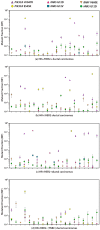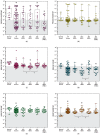Low-Frequency Mutational Heterogeneity of Invasive Ductal Carcinoma Subtypes: Information to Direct Precision Oncology
- PMID: 30813596
- PMCID: PMC6429455
- DOI: 10.3390/ijms20051011
Low-Frequency Mutational Heterogeneity of Invasive Ductal Carcinoma Subtypes: Information to Direct Precision Oncology
Abstract
Information regarding the role of low-frequency hotspot cancer-driver mutations (CDMs) in breast carcinogenesis and therapeutic response is limited. Using the sensitive and quantitative Allele-specific Competitor Blocker PCR (ACB-PCR) approach, mutant fractions (MFs) of six CDMs (PIK3CA H1047R and E545K, KRAS G12D and G12V, HRAS G12D, and BRAF V600E) were quantified in invasive ductal carcinomas (IDCs; including ~20 samples per subtype). Measurable levels (i.e., ≥ 1 × 10-5, the lowest ACB-PCR standard employed) of the PIK3CA H1047R, PIK3CA E545K, KRAS G12D, KRAS G12V, HRAS G12D, and BRAF V600E mutations were observed in 34/81 (42%), 29/81 (36%), 51/81 (63%), 9/81 (11%), 70/81 (86%), and 48/81 (59%) of IDCs, respectively. Correlation analysis using available clinicopathological information revealed that PIK3CA H1047R and BRAF V600E MFs correlate positively with maximum tumor dimension. Analysis of IDC subtypes revealed minor mutant subpopulations of critical genes in the MAP kinase pathway (KRAS, HRAS, and BRAF) were prevalent across IDC subtypes. Few triple-negative breast cancers (TNBCs) had appreciable levels of PIK3CA mutation, suggesting that individuals with TNBC may be less responsive to inhibitors of the PI3K/AKT/mTOR pathway. These results suggest that low-frequency hotspot CDMs contribute significantly to the intertumoral and intratumoral genetic heterogeneity of IDCs, which has the potential to impact precision oncology approaches.
Keywords: PIK3CA; TNBC; breast cancer; cancer-driver; heterogeneity; invasive ductal carcinoma; mutation; subclonal; triple-negative breast cancer.
Conflict of interest statement
We declare that we have no financial and personal relationships with other people or organizations that can inappropriately influence our work, there is no professional or other personal interest of any nature or kind in any product, service and/or company that could be construed as influencing the position presented in, or the review of, the manuscript entitled.
Figures





Similar articles
-
Breast Cancer Heterogeneity Examined by High-Sensitivity Quantification of PIK3CA, KRAS, HRAS, and BRAF Mutations in Normal Breast and Ductal Carcinomas.Neoplasia. 2016 Apr;18(4):253-63. doi: 10.1016/j.neo.2016.03.002. Neoplasia. 2016. PMID: 27108388 Free PMC article.
-
Variation in organ-specific PIK3CA and KRAS mutant levels in normal human tissues correlates with mutation prevalence in corresponding carcinomas.Environ Mol Mutagen. 2017 Aug;58(7):466-476. doi: 10.1002/em.22110. Epub 2017 Jul 29. Environ Mol Mutagen. 2017. PMID: 28755461 Free PMC article.
-
Analysis of circulating DNA and protein biomarkers to predict the clinical activity of regorafenib and assess prognosis in patients with metastatic colorectal cancer: a retrospective, exploratory analysis of the CORRECT trial.Lancet Oncol. 2015 Aug;16(8):937-48. doi: 10.1016/S1470-2045(15)00138-2. Epub 2015 Jul 13. Lancet Oncol. 2015. PMID: 26184520 Free PMC article.
-
Recommendations from the EGAPP Working Group: can testing of tumor tissue for mutations in EGFR pathway downstream effector genes in patients with metastatic colorectal cancer improve health outcomes by guiding decisions regarding anti-EGFR therapy?Genet Med. 2013 Jul;15(7):517-27. doi: 10.1038/gim.2012.184. Epub 2013 Feb 21. Genet Med. 2013. PMID: 23429431
-
The PIK3CA gene and its pivotal role in tumor tropism of triple-negative breast cancer.Transl Oncol. 2024 Dec;50:102140. doi: 10.1016/j.tranon.2024.102140. Epub 2024 Oct 5. Transl Oncol. 2024. PMID: 39369580 Free PMC article. Review.
Cited by
-
The Correlation of Mutations and Expressions of Genes within the PI3K/Akt/mTOR Pathway in Breast Cancer-A Preliminary Study.Int J Mol Sci. 2021 Feb 19;22(4):2061. doi: 10.3390/ijms22042061. Int J Mol Sci. 2021. PMID: 33669698 Free PMC article.
-
Quantification of cancer driver mutations in human breast and lung DNA using targeted, error-corrected CarcSeq.Environ Mol Mutagen. 2020 Nov;61(9):872-889. doi: 10.1002/em.22409. Epub 2020 Sep 28. Environ Mol Mutagen. 2020. PMID: 32940377 Free PMC article.
-
Rationale and Roadmap for Developing Panels of Hotspot Cancer Driver Gene Mutations as Biomarkers of Cancer Risk.Environ Mol Mutagen. 2020 Jan;61(1):152-175. doi: 10.1002/em.22326. Epub 2019 Oct 6. Environ Mol Mutagen. 2020. PMID: 31469467 Free PMC article. Review.
-
Outgrowth of erlotinib-resistant subpopulations recapitulated in patient-derived lung tumor spheroids and organoids.PLoS One. 2020 Sep 8;15(9):e0238862. doi: 10.1371/journal.pone.0238862. eCollection 2020. PLoS One. 2020. PMID: 32898185 Free PMC article.
References
-
- Hammond M.E., Hayes D.F., Dowsett M., Allred D.C., Hagerty K.L., Badve S., Fitzgibbons P.L., Francis G., Goldstein N.S., Hayes M., et al. American Society of Clinical Oncology/College Of American Pathologists guideline recommendations for immunohistochemical testing of estrogen and progesterone receptors in breast cancer. J. Clin. Oncol. 2010;28:2784–2795. doi: 10.1200/JCO.2009.25.6529. - DOI - PMC - PubMed
-
- Wolff A.C., Hammond M.E., Hicks D.G., Dowsett M., McShane L.M., Allison K.H., Allred D.C., Bartlett J.M., Bilous M., Fitzgibbons P., et al. Recommendations for human epidermal growth factor receptor 2 testing in breast cancer: American Society of Clinical Oncology/College of American Pathologists clinical practice guideline update. J. Clin. Oncol. 2013;31:3997–4013. doi: 10.1200/JCO.2013.50.9984. - DOI - PubMed
MeSH terms
Substances
LinkOut - more resources
Full Text Sources
Medical
Molecular Biology Databases
Research Materials
Miscellaneous

